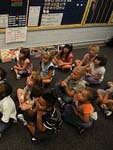







Introduction What About Freire? The Pink Monkey Psst! Wanna Buy A...? And His Pants Are Ugly Conclusions Opinions References and Credits |
My
opinion of all this? And of Who
Owns School? Though I may have not emphasized it sufficiently
in this review, Ritter
is a provocative, rigorous and persuasive writer, articulating her
positions eloquently through the lenses of rhetorical and composition
theory, literacy studies, and literary theory. If I disagree with
her at all, it’s on what may be a tangential point, but still one worth
pondering. Early in the book she suggests that the only students
who really seem to “appreciate and respond to the presence of a
teacher-figure” these days are, in her experience, graduate students;
her (qualified, but still strong) suggestion that undergrads no longer
feel the need for teachers in their lives is contradicted by my own
experience, which suggests that face-to-face (ok, f2f) contact with
teachers as well as peers is still crucial for a large number of
undergraduates. And I don’t think I’m just deluding myself about
the importance of my own influence. Possibly it’s because I
direct a writing center, but every day I see (and read about, if the National Survey of Student
Engagement is any indication)
undergraduates seeking in-person conversations about matters ranging
from their career goals to their papers-in-progress. This hunger,
it seems to me, for actual human contact points to what I think is
ultimately the problem with American education: the system has made
objects, figures, of teachers—a point Ritter addresses at length in
Chapter 5—and has not engaged sufficiently with what years of
pedagogical and educational research, including that in composition and
rhetoric, has revealed about how students actually learn. But, again, that’s a minor quibble, and ultimately irrelevant to Ritter’s goal in the book, which is not to offer blueprints for a newly imagined American educational system or (as she herself says) to provide “a how-to lesson in using or addressing online technologies in teaching” (p. 12). The most compelling aspect of Who Owns School? is its incisive analysis of the conversations students have on and about online sites, as well as of the consumerist rhetoric deployed by paper mills to exploit students’ disengagement. That analysis will complicate and, hopefully, change the way you think about your students as thinkers, learners and citizens. Read this book. In Ritter’s own words, “If you, the reader, opened this book and found yourself doubting what I might reasonably theorize about literacy education and…Web sites with silly, faddish names that you had never heard of, then I’m directing a prompt personally to you—because your spheres, I’m sorry to say, are not as wide as you may have previously thought.” |